-
Tim Randolph and Karol Węgrzycki.
"Beating Meet-in-the-Middle for Subset Balancing Problems." Preprint, 2025.
arXiv version
We consider exact algorithms for Subset Balancing, a family of related problems that generalizes Subset Sum, Partition, and Equal Subset Sum. Specifically, given as input an integer vector \(\vec{x} \in \mathbb{Z}^n\) and a constant-sized coefficient set \(C \subset \mathbb{Z}\), we seek a solution vector \(\vec{c} \in C^n\), \(\vec{c} \neq \vec{0}\) satisfying \(\vec{c} \cdot \vec{x} = 0\).
For \(C = \{-d,\ldots,d\}\), \(d > 1\) and \(C = \{-d,\ldots,d\}\setminus\{0\}\), \(d > 2\), we present algorithms that run in time \(O(|C|^{(0.5 - \epsilon)n})\) for a constant \(\epsilon > 0\) that depends only on \(C\). These are the first algorithms that break the \(O(|C|^{n/2})\)-time ``Meet-in-the-Middle barrier'' for these coefficient sets in the worst-case. This improves on the result of Chen, Jin, Randolph and Servedio (SODA 2022), who broke the Meet-in-the-Middle barrier on these coefficient sets in the average-case setting. Additionally, our techniques allow us to improve the best exact algorithm for Equal Subset Sum (Subset Balancing with \(C = \{-1,0,1\}\)), due to Mucha, Nederlof, Pawlewicz and Węgrzycki (ESA 2019), by an exponential margin. Our results leave two major coefficient sets for which we cannot yet break the Meet-in-the-Middle barrier: \(C = \{-2, -1, 1, 2\}\) and \(C = \{-1, 1\}\) (Subset Sum).
-
Xi Chen, Shivam Nadimpalli, Tim Randolph, Rocco Servedio, and Or Zamir.
"Testing Sumsets is Hard." ESA 2025.
arXiv version
A subset S of the Boolean hypercube \(\mathbb{F}^n_2\) is a sumset if \( S=\{a+b:a,b \in A\}\) for some \(A \in \mathbb{F}^n_2\). Sumsets are central objects of study in additive combinatorics, featuring in several influential results. We prove a lower bound of \( \Omega(2^{n/2}) \) for the number of queries needed to test whether a Boolean function \( f : \mathbb{F}^n_2 \rightarrow \{0,1\} \) is the indicator function of a sumset. Our lower bound for testing sumsets follows from sharp bounds on the related problem of shift testing, which may be of independent interest. We also give a near-optimal \(2^{n/2} \cdot poly(n)\)-query algorithm for a smoothed analysis formulation of the sumset refutation problem.
-
Ryan E. Dougherty, Tim Randolph, Tzu-Yi Chen, Jeff Erickson, Matthew Ferland, Dennis Komm, Jonathan Liu, Timothy Ng, Smaranda Sandu, Michael Shindler, Edward Talmage, and Thomas Zeume.
"A Survey of Undergraduate Theory of Computing Curricula."
SIGCSE Virtual 2024.
ACM DL
PDF
Theory of Computing (ToC) is an important aspect of nearly every undergraduate CS curriculum, as it concerns what computation fundamentally means. However, there has been little research into ToC pedagogy, both within the classroom and how it fits within its institutional context. We propose in this working group to create a survey of current ToC pedagogy. Our goals are to create a standard for teaching ToC, find trends, determine under-researched areas, and to build a community among ToC educators.
-
Tim Randolph and Karol Węgrzycki.
"Parameterized Algorithms on Integer Sets with Small Doubling: Freiman’s Theorem, Subset Sum and k-Sum." ESA 2024.
arXiv version
We study the parameterized complexity of algorithmic problems whose input is an integer set A in terms of the doubling constant \(C:=|A+A|/|A|\), a fundamental measure of additive structure. We present evidence that this new parameterization is algorithmically useful in the form of new results for two difficult, well-studied problems: Integer Programming and Subset Sum.
First, we show that determining the feasibility of bounded Integer Programs is a tractable problem when parameterized in the doubling constant. Specifically, we prove that the feasibility of an integer program I with n polynomially-bounded variables and m constraints can be determined in time \(n^{O_C(1)} poly(|I|)\) when the column set of the constraint matrix has doubling constant C.
Second, we show that the Subset Sum and Unbounded Subset Sum problems can be solved in time \(n^{O_C(1)}\) and \(n^{O_C(\log \log \log n)}\), respectively, where the \(O_C\) notation hides functions that depend only on the doubling constant C. We also show the equivalence of achieving an FPT algorithm for Subset Sum with bounded doubling and achieving a milestone result for the parameterized complexity of Box ILP. Finally, we design near-linear time algorithms for k-SUM as well as tight lower bounds for 4-SUM and nearly tight lower bounds for k-SUM, under the k-SUM conjecture. Several of our results rely on a new proof that Freiman's Theorem, a central result in additive combinatorics, can be made efficiently constructive.
-
Tim Randolph. "Exact and Parameterized Algorithms for Subset Sum Problems." PhD Thesis, 2024. PDF
We present a variety of exact and parameterized algorithms for Subset Sum and other related problems. The major contributions of this thesis include:
- 1. Average-case algorithms for Generalized Subset Sum, the problem that generalizes both Subset Sum and Equal Subset Sum, as well as structural results describing the parameter regime in which solutions exist. These results extend the application of the "Representation Method" and are the fastest known in this setting.
- 2. A proof that Either-Or Subset Sum, the problem of solving either Subset Sum or Equal Subset Sum, can be solved exponentially faster than time \(2^{0.5n}\) in the worst case. In our view, this result illustrates the potential of the "structure vs. randomness" approach for Subset Sum.
- 3. Algorithms that solve worst-case Subset Sum faster than time \(2^{0.5n}\) by a polynomial factor. These improvements on the best known exact algorithms for Subset Sum represent the successful application of "log shaving" techniques to the problem.
- 4. Algorithms for Subset Sum and \(k\)-SUM with constant doubling. When considered in terms of a novel parameterization in the doubling constant, Subset Sum admits an XP-algorithm, while \(k\)-SUM is Fixed-Parameter Tractable. We also show that Subset Sum is FPT in the doubling constant if and only if an instance \(\mathcal{I}\) of Hyperplane-Constrained Integer Linear Programming with \(n\) variables, \(m\) constraints, and constraint matrix entries bounded by \(\Delta\) can be solved in time \(\Delta^{O(m)} \cdot poly(|\mathcal{I}|)\).
-
Tim Randolph. "Participatory Governance in the Computer Science Theory Classroom." SIGCSE Technical Symposium 2024. ACM Digital Library
We implemented pedagogical strategies designed to give students greater control over the use of class time and grading methods in a major-required computer science theory (CST) course. Our methodology addresses the challenges inherent in transferring more power to students in a lecture-based class with a curriculum that requires the sequential mastery of formal mathematical concepts.
We offered students increased control over four classroom variables: the degree of interactivity, the selection of in-class activities , increased emphasis on standards-based outcomes as opposed to averaging over all coursework, and the granularity of the grading schema used by TAs. In this experience report, we present our methodology, report on our classroom experience, and conclude that increasing student control over the undergraduate CST classroom via participatory governance can increase student motivation and encourage critical reflection in budding computer scientists.
-
Tim Randolph.
"Exact Algorithms for Finding Sumsets." Preprint, 2023.
PDF
-
Xi Chen, Yaonan Jin, Tim Randolph, and Rocco Servedio.
"Subset Sum in time \(2^{n/2} / poly(n)\)." RANDOM/APPROX 2023. arXiv version
A major goal in the area of exact exponential algorithms is to give an algorithm for the (worst-case) n-input Subset Sum problem that runs in time \(2^{(1/2−c)n}\) for some constant \(c>0\). In this paper we give a Subset Sum algorithm with worst-case running time \(O(2^{n/2⋅n−γ})\) for a constant \(γ>0.5023\) in standard word RAM or circuit RAM models. To the best of our knowledge, this is the first improvement on the classical "meet-in-the-middle" algorithm for worst-case Subset Sum, due to Horowitz and Sahni, which can be implemented in time \(O(2^{n/2})\) in these memory models.
Our algorithm combines a number of different techniques, including the "representation method" introduced by Howgrave-Graham and Joux and subsequent adaptations of the method in Austrin, Kaski, Koivisto, and Nederlof, and Nederlof and Wegrzycki, and "bit-packing" techniques used in the work of Baran, Demaine, and Patrascu on subquadratic algorithms for 3SUM.
-
Xi Chen, Yaonan Jin, Tim Randolph, and Rocco Servedio.
"Average-Case Subset Balancing Problems." SODA 2022. arXiv version
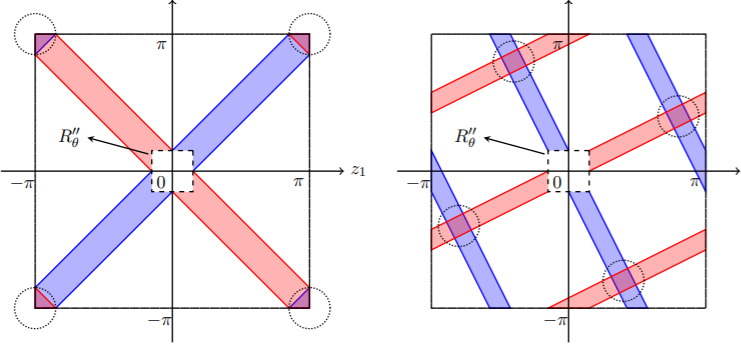
Given a set of \(n\) input integers, the Equal Subset Sum problem asks us to find two distinct subsets with the same sum. In this paper we present an algorithm that runs in time \(O^*(3^{0.387n})\) in the~average case, significantly improving over the \(O^*(3^{0.488n})\) running time of the best known worst-case algorithm and the Meet-in-the-Middle benchmark of \(O^*(3^{0.5n})\).
Our algorithm generalizes to a number of related problems, such as the Generalized Equal Subset Sum problem, which asks us to assign a coefficient \(c_i\) from a set \(C\) to each input number \(x_i\) such that \(\sum_{i} c_i x_i = 0\). Our algorithm for the average-case version of this problem runs in~time \(|C|^{(0.5-c_0/|C|)n}\) for some positive constant \(c_0\), whenever \(C=\{0, \pm 1, \dots, \pm d\}\) or \(\{\pm 1, \dots, \pm d\}\) for some positive integer \(d\) (with \(O^*(|C|^{0.45n})\) when \(|C|<10\)).
Our results extend to the~problem of finding "nearly balanced" solutions in which the target is a not-too-large nonzero offset \(\tau\).
Our approach relies on new structural results that characterize the probability that \(\sum_{i} c_i x_i =\tau\) has a solution \(c \in C^n\) when \(x_i\)'s are chosen randomly; these results may be of independent interest. Our algorithm is inspired by the "representation technique" introduced by Howgrave-Graham and Joux. This requires several new ideas to overcome preprocessing hurdles that arise in the representation framework, as well as a novel application of dynamic programming in the solution recovery phase of the algorithm.
-
Marshall Ball and Tim Randolph.
"A Note on the Complexity of Private Simultaneous Messages with Many Parties." ITC 2022.
Conference version
-
Nick Arnosti and Tim Randolph.
"Parallel Lotteries: Insights from Alaskan Hunting Permit Allocation." Management Science 2021; EC 2021.
SSRN version
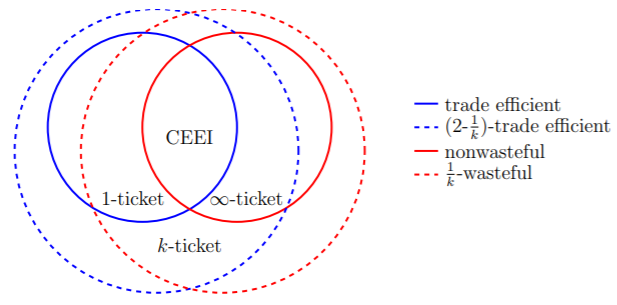
We analyze the \(k\)-ticket lottery, which is used to allocate hunting permits in the state of Alaska. Each participant is given \(k\) tickets to distribute among lotteries for different types of items. Participants who win multiple items receive their favorite, and new winners are drawn from the lotteries with unclaimed items.
When supply is scarce, equilibrium outcomes of the \(k\)-ticket lottery approximate a competitive equilibrium from equal incomes (CEEI), which is Pareto efficient. When supply is moderate, \(k\)-ticket lotteries exhibit two sources of inefficiency. First, some agents may benefit from trading probability shares. Second, outcomes may be "wasteful": agents may receive nothing even if acceptable items remain unallocated. We bound both sources of inefficiency, and show that each is eliminated by a suitable choice of \(k\): trades are never beneficial when \(k=1\), and waste is eliminated as \(k\) approaches infinity.
The wastefulness of the \(k\)-ticket lottery has some benefits: agents with strong preferences may prefer \(k\)-ticket lottery outcomes to those of any nonwasteful envy-free mechanism. These agents prefer small values of \(k\), while agents with weak preferences prefer large values of \(k\). Together, these results suggest that the \(k\)-ticket lottery performs well under most circumstances, and may be suitable for other settings where items are rationed.
-
Xi Chen, Tim Randolph, Rocco Servedio, and Tim Sun.
"A Lower Bound on Cycle Finding in Sparse Digraphs." SODA 2020.
arXiv version
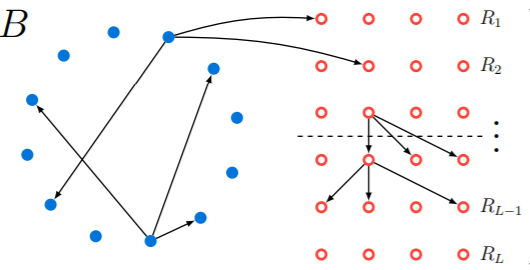
We consider the problem of finding a cycle in a sparse directed graph \(G\) that is promised to be far from acyclic, meaning that the smallest feedback arc set in \(G\) is large. We prove an information-theoretic lower bound, showing that for \(N\)-vertex graphs with constant outdegree any algorithm for this problem must make \(\tilde{\Omega}(N^{5/9})\) queries to an adjacency list representation of \(G\). In the language of property testing, our result is an \(\tilde{\Omega}(N^{5/9})\) lower bound on the query complexity of one-sided algorithms for testing whether sparse digraphs with constant outdegree are far from acyclic. This is the first improvement on the \(\tilde{\Omega}(\sqrt{N})\) lower bound, implicit in Bender and Ron, which follows from a simple birthday paradox argument.
-
Emilio Di Giacomo, William J. Lenhart, Giuseppe Liotta, Timothy W. Randolph and Alessandra Tappini.
"(k,p)-Planarity: A Relaxation of Hybrid Planarity." WALCOM 2019.
arXiv version

We present a new model for hybrid planarity that relaxes existing hybrid representations. A graph \(G=(V,E)\) is \((k,p)\)-planar if \(V\) can be partitioned into clusters of size at most \(k\) such that \(G\) admits a drawing where: (i) each cluster is associated with a closed, bounded planar region, called a cluster region; (ii) cluster regions are pairwise disjoint, (iii) each vertex \(v \in V\) is identified with at most \(p\) distinct points, called ports, on the boundary of its cluster region; (iv) each inter-cluster edge \((u,v)\in E\) is identified with a Jordan arc connecting a port of \(u\) to a port of \(v\); (v) inter-cluster edges do not cross or intersect cluster regions except at their endpoints. We first tightly bound the number of edges in a \((k,p)\)-planar graph with \(p<k\). We then prove that \((4,1)\)-planarity testing and \((2,2)\)-planarity testing are NP-complete problems. Finally, we prove that neither the class of \((2,2)\)-planar graphs nor the class of \(1\)-planar graphs contains the other, indicating that the \((k,p)\)-planar graphs are a large and novel class.
-
Timothy W. Randolph.
"Asymptotically Optimal Bounds for \((t,2)\) Broadcast Domination on Finite Grids."
Rose-Hulman Undergraduate Mathematics Journal 20, 2019.
arXiv version
Let \(G=(V,E)\) be a graph and \(t,r\) be positive integers. The signal that a tower vertex \(T\) of signal strength \(t\) supplies to a vertex \(v\) is defined as \(sig(T,v)=max(t−dist(T,v),0)\), where \(dist(T,v)\) denotes the distance between the vertices \(v\) and \(T\). In 2015 Blessing, Insko, Johnson, and Mauretour defined a \((t,r)\) broadcast dominating set, or simply a \((t,r)\) broadcast, on \(G\) as a set \(T \subseteq V\) such that the sum of all signals received at each vertex \(v\in V\) from the set of towers \(T\) is at least \(r\). The \((t,r)\) broadcast domination number of a finite graph \(G\), denoted \(\gamma_{t,r}(G)\), is the minimum cardinality over all \((t,r)\) broadcasts for \(G\).
Recent research has focused on bounding the \((t,r)\) broadcast domination number for the \(m \times n\) grid graph \(G_{m,n}\). In 2014, Grez and Farina bounded the \(k\)-distance domination number for grid graphs, equivalent to bounding \(\gamma_{t,1}(G_{m,n})\). In 2015, Blessing et al. established bounds on \(\gamma_{2,2}(G_{m,n})\), \(\gamma_{3,2}(G_{m,n})\), and \(\gamma_{3,3}(G_{m,n})\). In this paper, we take the next step and provide a tight upper bound on \(\gamma_{t,2}(G_{m,n})\) for all \(t>2\). We also prove the conjecture of Blessing et al. that their bound on \(\gamma_{3,2}(G_{m,n})\) is tight for large values of \(m\) and \(n\).
-
Benjamin F. Drews, Pamela E. Harris, and Timothy W. Randolph.
"Optimal \((t,r)\) Broadcasts on the Infinite Grid."
Discrete Applied Mathematics 255, 2018.
arXiv version
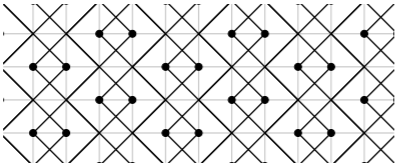
Let \(G=(V,E)\) be a graph and \(t,r\) be positive integers. The signal that a tower vertex \(T\) of signal strength \(t\) supplies to a vertex \(v\) is defined as \(sig(T,v)=max(t−dist(T,v),0)\), where \(dist(T,v)\) denotes the distance between the vertices \(v\) and \(T\). In 2015 Blessing, Insko, Johnson, and Mauretour defined a \((t,r)\) broadcast dominating set, or simply a \((t,r)\) broadcast, on \(G\) as a set \(T \subseteq V\) such that the sum of all signals received at each vertex \(v\in V\) from the set of towers \(T\) is at least \(r\). We say that \(T\) is optimal if \(|T|\) is minimal among all such sets \(T\). The cardinality of an optimal \((t,r)\) broadcast on a finite graph \(G\) is called the \((t,r)\) broadcast domination number of \(G\). The concept of \((t,r)\) broadcast domination generalizes the classical problem of domination on graphs. In fact, the \((2,1)\) broadcasts on a graph G are exactly the dominating sets of \(G\).
In their paper, Blessing et al. considered \((t,r) \in \{(2,2),(3,1),(3,2),(3,3)\}\) and gave optimal \((t,r)\) broadcasts on \(G_{m,n}\), the grid graph of dimension \(m\times n\), for small values of \(m\) and \(n\). They also provided upper bounds on the optimal \((t,r)\) broadcast numbers for grid graphs of arbitrary dimensions. In this paper, we define the density of a \((t,r)\) broadcast, which allows us to provide optimal \((t,r)\) broadcasts on the infinite grid graph for all \(t \geq 2\) and \(r=1,2\), and bound the density of the optimal \((t,3)\) broadcast for all \(t \geq 2\). In addition, we give a family of counterexamples to the conjecture of Blessing et al. that the optimal \((t,r)\) and \((t+1,r+2)\) broadcasts are identical for all \(t \geq 1\) and \(r \geq 1\) on the infinite grid.
-
Timothy W. Randolph, advised by William J. Lenhart.
"\((k,p)\)-Planar Graphs: A Generalization of Planar Representations for Cluster Graphs."
2018.
PDF
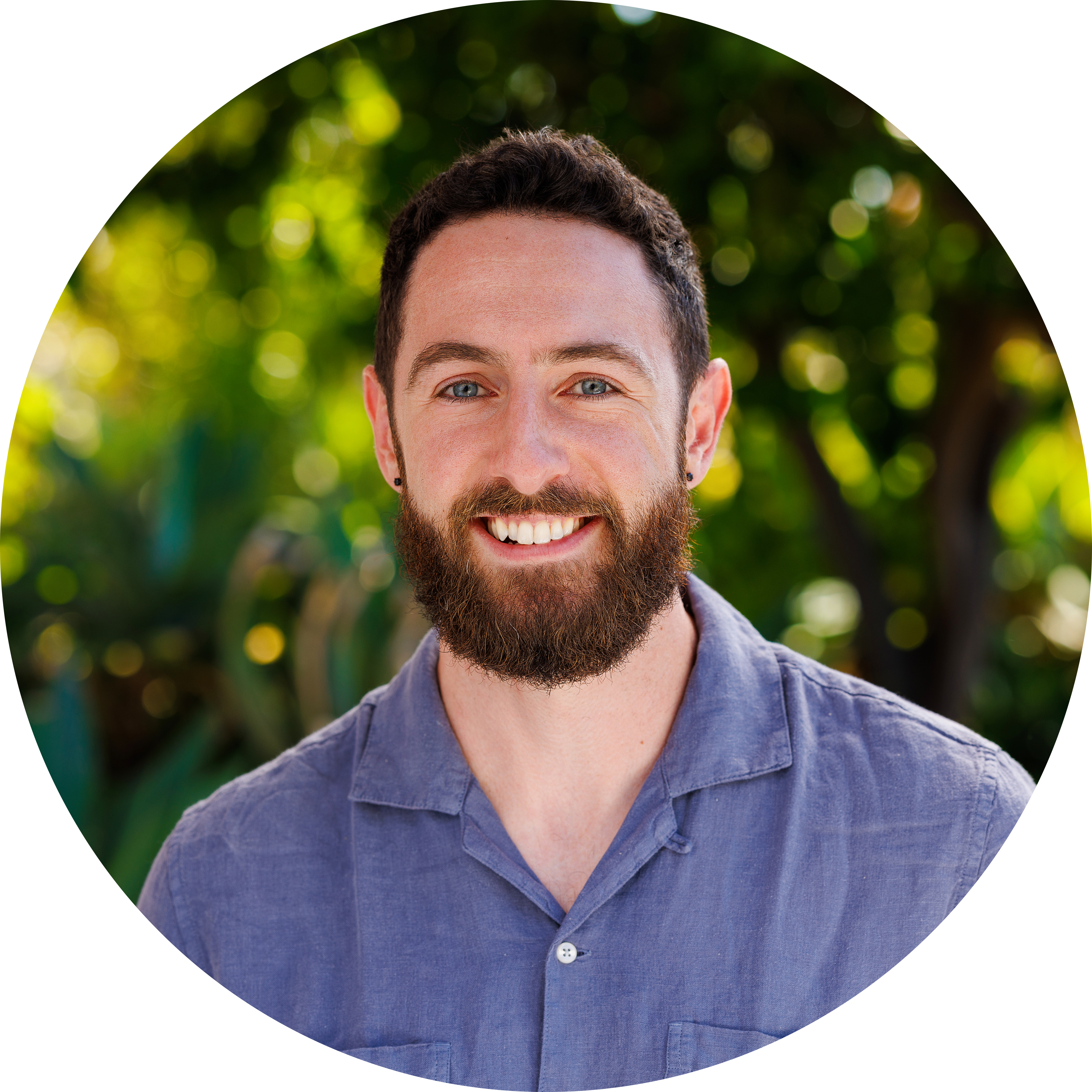


 LICENSED UNDER CC BY-SA 2015-2023.
LICENSED UNDER CC BY-SA 2015-2023.